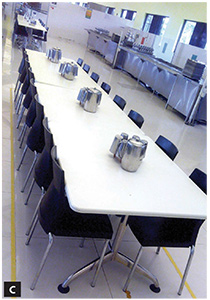Scrap Yard
There is a perception that following the 5S concept demands allocation of more space as it may require a space for scrap yard; and this is becoming a deterrent. However, Ram denied it, saying that space availability will increase as clutter is reduced. Red tagged items can even be sold as scrap, eventually unlocking cash for the company. Also, it convinces people that they can work with less space. Moreover, it helps in relaying the machine to get more space, which can be used for capacity expansion without actually expanding the floor space. In India, auto components manufacturers are in semi-urban areas where land is expensive. 5S will become a saviour of sorts, when this building block is looked at along with layout changes etc.
Scrap yard, especially of wooden waste, at Hyundai Motor India is yet again a manufacturing unit. Rather than selling it off the company makes desks and benches with the waste packaging wood and donates it to schools in the local area.
Even during construction the OEM followed 5S. And that is why it has become part of the system from day one says Sarangarajan. “Even during building the plant Hyundai management was insisting in sorting and arranging the materials before construction. This helped the company to complete the construction before the stipulated time.”
Challenges
Suri opines that in real terms there are no pain areas; however, implementation of new practices is accompanied by resistance. “5S is not a magic pill that solves every workplace problem. That’s why there are other lean manufacturing techniques such as kaizen, TPM, SMED and kanban,” he says. Each of these addresses different problems, but they all also have some overlap and work together synergistically.
 A. Scrapyard turned Carpentry at Hyundai Motor India B. Scrapyard converted to Waste Management at Fairfield Atlas
A. Scrapyard turned Carpentry at Hyundai Motor India B. Scrapyard converted to Waste Management at Fairfield Atlas
The major problem with 5S appears when it is not properly understood, used or implemented. According to him the issues include resistance to change, lack of management support and misunderstanding of what 5S accomplishes. When compared to cost, it may be the most effective lean technique. However, it takes more than 5S to find and eliminate waste, and maximise the use of resources.
The problems and disadvantages of 5S are not that it does not work; it arises from unrealistic expectations espeespecially when not properly implemented. One approach to implement 5S is by applying it at a pace at which people become used to the new way of doing things, another approach to implement change is to get employee buyin. This means that the ideas to implement it come from the employees. “Ensure management and supervisory staff is updated and completely support it. This is a bottom-up approach in which employees are endowed with the capability of identifying the problems (through training) and implement the solutions by applying 5S principles,” he adds.
MSMEThe major challenge in implementing any new programme by MSME is the availability of management’s bandwidth. This is because in smaller organisations the owner is himself the manager and operator, to some extent. “I think some amount of managerial bandwidth has to be built up in organisations if they want to grow,” indicates Ram.
Road Ahead
The 5S concept helps the organisation to be preventive on any failures. “Basically, manufacturing excellence is all about reducing losses. It is a motivational factor and a percept towards engaging people with manufacturing to eventually improve overall productivity. Now ACT is working on advanced clusters where we propagate advanced 5S with higher levels of intensity. For example, in the engineering cluster, we have asked the CEOs, would they be comfortable to have a meal sitting on their shopfloor?” says Ram.
According to the ACMA President, the apex body, as on date, has supported 450 plus plants all over India to improve manufacturing through 5S. It includes Total Employees Involvement (TEI), Quality & Productivity improvement, Equipment and Inventory management, Lean Processes and Lean tooling. “Companies that have adopted 5S have excelled and are role models for others to follow suit,” reiterates Suri.
Ram emphasises that there needs to be a lot more hand holding across the board of Tiers 1, 2 and 3 companies in order to make it more prolific, which Hyundai Motor India has already been doing. The vehicle manufacturer is propagating 5S to its vendors to make this a movement. The Tier-2 and Tier-3 companies may resist as they can ill afford investing for these concepts. They don’t realise that these will ultimately help. “We tell them that what you do is not for your customer, the Tier-1 companies, but for yourself as it will give them several benefits. Of late, we have begun inviting Tire-2 and Tier-3 companies for vendor conferences, which was confined to only Tier-1s. Besides this, we speak to Tier-2 and Tier-3 more often, which has helped them in enhancing their morale and motivation. We tell them to maintain inventory at the right level for making more profit,” Sarangarajan declares. ACI














Leave a Reply